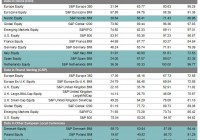ETF Strategies To Gain From In The Rest Of 2016
After a lackluster patch, the broader market showed some strength in Q2, but occasional volatility is still showing up. The S&P 500 is striving to stay in the green from the year-to-date look (as of May 18, 2016) (read: S&P 500 Again Shows Weakness: Go Short with These ETFs ). Several marked changes were noticed during this time, including the solid comeback in oil prices and subtle stabilization in the Chinese economy. But it seems that the S&P 500 is far from seeing its past success in the rest of this year. Though the U.S. economy started taking root lately and is expected to see upbeat growth in Q2, volatility will likely rule the market. Imminent ‘Brexit’ vote, further Fed rate hikes and the U.S. election in November will definitely not let the market stay calm (read: British ETFs in Focus on Brexit Talks ). Investors should note that though the Fed hike symbolizes a steady U.S. economy, the imminent reaction is a crash in the stock market in fear of a dearth in cheap money inflows. Against this backdrop, investors may want to know some worthwhile investing strategies. For them we highlight the trending policies in the market and some profitable ETF bets. Analysts Muted on Stocks Bank of America believes that the S&P 500 could slip to its February lows, while Morgan Stanley has applied the famous maxim “Sell in May and go away” to stocks at least till November. Goldman Sachs has also cut its outlook on equities to “neutral” over the coming one year. Now Goldman has gone “neutral” on U.S. (upgraded), Europe (downgraded), Japan (downgraded) and Asia ex-Japan equities. Europe and Japan definitely bear the burden of stronger currencies and weaker financial sectors due to the ongoing negative interest rates. On the other hand, U.S. equities may suffer from choppy earnings, overvaluation concerns and the Fed move. The ripple effects of any crash in the S&P 500 may shake stocks worldwide. So, it’s better to bet on the ProShares Short S&P 500 ETF (NYSEARCA: SH ) , the ProShares Short MSCI Emerging Markets ETF (NYSEARCA: EUM ) , or the ProShares Short MSCI EAFE ETF (NYSEARCA: EFZ ) . Time for Money Market Instruments? As per Goldman, cash can be an overweight pick this year due to fewer chances of a Fed rate hike. In such a situation, investors can bet on cash-like money market ETFs like the Guggenheim Enhanced Short Duration Bond ETF (NYSEARCA: GSY ) and the SPDR Barclays 1-3 Month T-Bill ETF (NYSEARCA: BIL ) . One thing is for sure, a rate hike will hit both stocks and bonds. This is because as the Fed enacts, yields will jump pushing bond prices down. Even Goldman is worrying about the interest rate shock. Investment Grade Corporate Bonds: Safety + Yield Investors can also consider long-term corporate bond ETFs like the Vanguard Long-Term Corporate Bond Index ETF (NASDAQ: VCLT ) for higher yields than treasuries. Goldman Sachs now expects its year-end 10-year yield to be 2.4%, down from the 2.75% it had projected in the first quarter. Bank of America Merrill Lynch pared down its forecast for the yearend 10-year yield to 2% from 2.65% at the start of the year. Morgan Stanley projects a lower 10-year yield at 1.75%, down from 2.7% when the year had started. So, the drive for higher yield is expected in the marketplace. However, since corporate bonds are riskier in nature, honing in on investment-grade ones is a prerequisite. After all, corporate leverage is peaking, so investors need to be aware of default risks. VCLT yields 4.30% annually (as of May 18, 2016). Play Rebound in Oil; but Tread Cautiously Oil prices have seen a lot in last two years. Now that things are turning in favor for oil with shrinking supply glut and a possible recovery in demand, a play on oil is warranted. With oil, investors can also bet on high-yield bond ETFs like the AdvisorShares Peritus High Yield ETF (NYSEARCA: HYLD ) . This is because of the fact that the U.S. energy companies are closely tied to the high-yield bond market, with the former comprising a considerable amount of junk bond issuance. Volatility to Crack the Whip: Play Risk Aware Volatility is expected to be strong in 2016. Investors can deal with this in various ways. While low volatility ETFs like the PowerShares S&P 500 Low Volatility Portfolio ETF (NYSEARCA: SPLV ) can be an option, defensive ETFs like the QuantShares U.S. Market Neutral Anti-Beta ETF (NYSEARCA: BTAL ) and risk-aware ETFs like the SPDR SSgA Risk Aware ETF (NYSEARCA: RORO ) can be tapped too. And last but not the least in queue are volatility ETFs themselves such as the C-Tracks on Citi Volatility Index ETN (NYSEARCA: CVOL ) and the ProShares VIX Short-Term Futures ETF (NYSEARCA: VIXY ) . Notably, as the name suggests, volatility products are quite rowdy in nature and thus suit investors with a short-term notion. Gold to Hit $1,400? Steep Fed tightening or not, the gold market looks shiny thanks to global political risks this year. Along with many other optimistic analysts, Denmark’s Saxo Bank A/S turned bullish on gold and projected that the price may hit as high as $1,400 this year. This invariably puts gold ETFs like the SPDR Gold Trust ETF (NYSEARCA: GLD ) in focus. Link to the original post on Zacks.com
